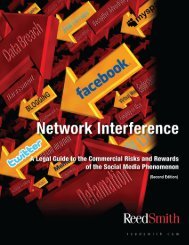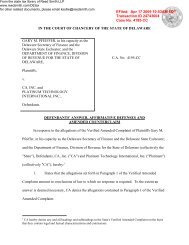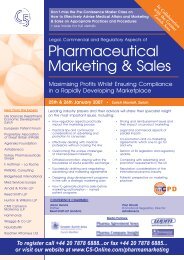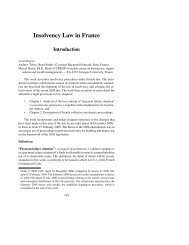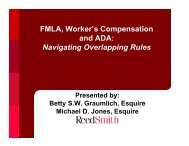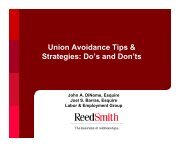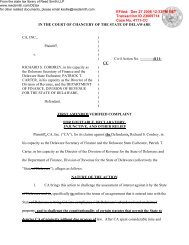Code of Practice for pre-action conduct in intellectual ... - Reed Smith
Code of Practice for pre-action conduct in intellectual ... - Reed Smith
Code of Practice for pre-action conduct in intellectual ... - Reed Smith
Create successful ePaper yourself
Turn your PDF publications into a flip-book with our unique Google optimized e-Paper software.
CODE OF PRACTICE<br />
FOR PRE-ACTION CONDUCT IN<br />
INTELLECTUAL PROPERTY DISPUTES
CONTENTS<br />
Page Number<br />
Introduction<br />
The Commitee Members<br />
ii<br />
iii<br />
Aims <strong>of</strong> the <strong>Code</strong> 1<br />
Scope <strong>of</strong> the <strong>Code</strong> 1<br />
Letter <strong>of</strong> Claim 3<br />
Letter <strong>of</strong> Response 3<br />
Issue <strong>of</strong> Proceed<strong>in</strong>gs 5<br />
Alternative Dispute Resolution 5<br />
Appendix A<br />
Breach <strong>of</strong> Confidence 6<br />
Appendix B<br />
Copyright, Moral Right, Database Right and Unregistered Design Right 8<br />
Appendix C<br />
Pass<strong>in</strong>g Off 10<br />
Appendix D<br />
Patent and Registered Design 12<br />
Appendix E<br />
Registered Trade Marks 14<br />
Appendix F<br />
Unjustified Threats 17<br />
i
INTRODUCTION BY THE CHAIR OF THE COMMITTEE<br />
A couple <strong>of</strong> years ago, I was asked by The Law Society to assemble a Committee to draft<br />
<strong>pre</strong>-<strong>action</strong> protocols <strong>for</strong> <strong>in</strong>tellectual property which were then <strong>in</strong>tended to <strong>for</strong>m part <strong>of</strong><br />
the Civil Procedure Rules. I was <strong>for</strong>tunate to be able to <strong>pre</strong>ss <strong>in</strong>to service a Committee<br />
comprised <strong>of</strong> many <strong>of</strong> the lead<strong>in</strong>g practitioners <strong>in</strong> the field, a list <strong>of</strong> whom appears below.<br />
The Committee worked very hard to produce <strong>pre</strong>-<strong>action</strong> protocols that would help to<br />
ensure that the <strong>pre</strong>-<strong>action</strong> behaviour <strong>of</strong> those <strong>in</strong>volved <strong>in</strong> <strong>in</strong>tellectual property disputes<br />
complied with the spirit <strong>of</strong> the overrid<strong>in</strong>g objective and that practitioners and <strong>in</strong>tellectual<br />
property owners knew what would be required <strong>of</strong> them. First drafts <strong>of</strong> the “protocols”<br />
were put out <strong>for</strong> consultation and we received very helpful comments from a wide range<br />
<strong>of</strong> <strong>in</strong>terested groups and <strong>in</strong>dividuals. The Committee would like to extend their thanks to<br />
all those who took the trouble to respond to the consultation.<br />
After the consultation had ended, the Committee updated the draft “protocols” but prior<br />
to the publication <strong>of</strong> the new drafts, the Committee was told that, <strong>in</strong> order to avoid a<br />
proliferation <strong>of</strong> protocols, a decision had been made by the judiciary not now to <strong>in</strong>troduce<br />
the <strong>in</strong>tellectual property <strong>pre</strong>-<strong>action</strong> protocols <strong>in</strong>to the Civil Procedure Rules. S<strong>in</strong>ce that<br />
decision, we have cont<strong>in</strong>ued to receive queries about the protocols and their progress.<br />
Many people have <strong>in</strong>dicated to us that they are us<strong>in</strong>g them and f<strong>in</strong>d<strong>in</strong>g them helpful. The<br />
Committee has there<strong>for</strong>e decided (with the support <strong>of</strong> Sir Hugh Laddie, who is one <strong>of</strong><br />
the Committee members) to publish the drafts that were produced after the consultation<br />
process <strong>in</strong> the <strong>for</strong>m <strong>of</strong> a <strong>Code</strong> <strong>of</strong> <strong>Practice</strong> so as to ensure that the most up to date<br />
version <strong>of</strong> the drafts is available to those who have found them useful and to assist and<br />
guide those who are deal<strong>in</strong>g with <strong>in</strong>tellectual property law disputes. The <strong>Code</strong> <strong>of</strong> <strong>Practice</strong><br />
takes <strong>in</strong>to account the comments received dur<strong>in</strong>g the course <strong>of</strong> the consultation process<br />
and recent changes <strong>in</strong> the law. It is not, <strong>of</strong> course, b<strong>in</strong>d<strong>in</strong>g. However, it does re<strong>pre</strong>sent the<br />
Committee’s assessment <strong>of</strong> what is reasonable <strong>pre</strong>-<strong>action</strong> behaviour <strong>in</strong> <strong>in</strong>tellectual<br />
property law disputes.<br />
I would like to thank the Committee members and all those who have supported this<br />
project <strong>in</strong>clud<strong>in</strong>g, <strong>in</strong> particular, Richard Ashmead <strong>of</strong> Kilburn & Strode and Jeff Watson <strong>of</strong><br />
the Patent Office.<br />
The law changes. This <strong>Code</strong> <strong>of</strong> <strong>Practice</strong> is <strong>in</strong>tended as a liv<strong>in</strong>g document. If you have any<br />
suggestions about it, we hope that you will tell us.<br />
Michael Skre<strong>in</strong><br />
London<br />
June, 2004<br />
ii
THE COMMITTEE MEMBERS<br />
David Attfield, BBC<br />
Ge<strong>of</strong>f Bayliss, Boult Wade Tennant<br />
Liz Coleman, The Patent Office<br />
Marcus Dalton, <strong>Smith</strong>Kl<strong>in</strong>e Beecham<br />
Susan Davey, BBC (who replaced Elizabeth Gibson <strong>of</strong> the BBC)<br />
Bridget Doherty, Department <strong>of</strong> Constitutional Affairs (who replaced Pat <strong>Reed</strong>)<br />
Sir Hugh Laddie, Royal Courts <strong>of</strong> Justice<br />
Tom Mitcheson, Three New Square<br />
Jonathan Rayner James QC, Hogarth Chambers<br />
Judith Sullivan, The Patent Office<br />
Clive Thorne, Denton Wilde Sapte<br />
Jeff Watson, The Patent Office<br />
Carolyn Jones, Richards Butler (Clerk)<br />
Michael Skre<strong>in</strong>, Richards Butler (Chair)<br />
iii
<strong>Code</strong> <strong>of</strong> <strong>Practice</strong> <strong>for</strong> <strong>pre</strong>-<strong>action</strong> <strong>conduct</strong> <strong>in</strong> <strong>in</strong>tellectual property disputes<br />
CODE OF PRACTICE FOR PRE-ACTION CONDUCT IN<br />
INTELLECTUAL PROPERTY DISPUTES<br />
1. AIMS OF THE CODE<br />
1.1 This <strong>Code</strong> sets out the steps which parties should follow where litigation<br />
is be<strong>in</strong>g considered, subject to paragraphs 2.2 and 2.4 below.<br />
1.2 Its aim is to encourage the parties to exchange <strong>in</strong><strong>for</strong>mation with each<br />
other prior to issu<strong>in</strong>g proceed<strong>in</strong>gs to ascerta<strong>in</strong> whether proceed<strong>in</strong>gs can be<br />
avoided and, if not, to ensure that the parties understand the issues<br />
sufficiently to ensure that any litigation is dealt with proportionately and<br />
<strong>in</strong> keep<strong>in</strong>g with the overrid<strong>in</strong>g objective. In follow<strong>in</strong>g the <strong>Code</strong>, the<br />
parties should behave reasonably at all times.<br />
2. SCOPE OF THE CODE<br />
2.1 This <strong>Code</strong> relates to <strong>in</strong>tellectual property disputes. It should be read <strong>in</strong><br />
conjunction with the Civil Procedure Rules and any relevant practice<br />
directions. It is <strong>in</strong>tended to apply to all <strong>in</strong>tellectual property claims. Where<br />
a claim is a mixed claim (<strong>for</strong> example, <strong>for</strong> copyright <strong>in</strong>fr<strong>in</strong>gement and<br />
breach <strong>of</strong> contract) the parties should follow all <strong>of</strong> the requirements <strong>of</strong><br />
any applicable <strong>pre</strong>-<strong>action</strong> protocols and/or codes as far as possible. In<br />
more complex claims it may be reasonable to extend the time limits<br />
suggested by this <strong>Code</strong>.<br />
2.2 There may be circumstances where parties consider that a departure from<br />
the <strong>Code</strong>, whether <strong>in</strong> whole or <strong>in</strong> part, is justified <strong>in</strong>clud<strong>in</strong>g, <strong>for</strong> example:<br />
• where it is reasonable <strong>for</strong> the claimant to apply <strong>for</strong> an <strong>in</strong>terim<br />
<strong>in</strong>junction with<strong>in</strong> a time scale or <strong>in</strong> a manner which does not<br />
reasonably allow full compliance with this <strong>Code</strong>;<br />
• where there is a reasonable and urgent need to issue proceed<strong>in</strong>gs to<br />
found jurisdiction;<br />
• where the limitation period is about to expire;<br />
1
<strong>Code</strong> <strong>of</strong> <strong>Practice</strong> <strong>for</strong> <strong>pre</strong>-<strong>action</strong> <strong>conduct</strong> <strong>in</strong> <strong>in</strong>tellectual property disputes<br />
• where a claim <strong>for</strong> unjustified threats might arise (see paragraph 2.4<br />
below);<br />
• where it would clearly be unreasonable to expect a party to comply<br />
with the <strong>Code</strong> as a result <strong>of</strong> matters aris<strong>in</strong>g from the parties’<br />
<strong>pre</strong>vious deal<strong>in</strong>gs.<br />
2.3 The letters <strong>of</strong> claim and response suggested by this <strong>Code</strong> are not <strong>in</strong>tended<br />
to have the same status as a statement <strong>of</strong> case. They should be sufficiently<br />
detailed so that each party may understand the case <strong>of</strong> the other.<br />
However, their <strong>pre</strong>paration should not place an unreasonable or<br />
disproportionate burden on either party <strong>in</strong> terms <strong>of</strong> cost.<br />
2.4 Attention is specifically drawn to the follow<strong>in</strong>g provisions:<br />
section 253 <strong>of</strong> the Copyright, Designs and Patents Act 1988;<br />
section 70 <strong>of</strong> the Patents Act 1977;<br />
section 26 <strong>of</strong> the Registered Designs Act 1949;<br />
section 21 <strong>of</strong> the Trade Marks Act 1994;<br />
paragraph 4 <strong>of</strong> the Community Trade Mark Regulations 1996<br />
paragraph 4(6) <strong>of</strong> the Trade Marks (International Registrations) Order<br />
1996<br />
These provisions create liability <strong>in</strong> tort <strong>for</strong> mak<strong>in</strong>g unjustified threats <strong>of</strong><br />
<strong>in</strong>fr<strong>in</strong>gement <strong>of</strong> a design right, patent, registered design and registered<br />
trade mark respectively. Claimants and their advisers should be aware that<br />
unless their letter <strong>of</strong> claim falls with<strong>in</strong> the exceptions set out <strong>in</strong> the above<br />
sections, by follow<strong>in</strong>g the provisions <strong>of</strong> this <strong>Code</strong> they may make<br />
themselves liable <strong>for</strong> the tort <strong>of</strong> unjustified threats. There is a possibility<br />
that relief (<strong>in</strong>clud<strong>in</strong>g a declaration, damages and an <strong>in</strong>junction to <strong>pre</strong>vent<br />
further threats) will be granted aga<strong>in</strong>st them by the court as a result <strong>of</strong> a<br />
claim or counterclaim <strong>for</strong> unjustified threats. Accord<strong>in</strong>gly, there may be<br />
cases where a claimant can reasonably justify not hav<strong>in</strong>g sent a letter <strong>of</strong><br />
claim on the grounds that to do so was likely to lead to a claim or<br />
counterclaim <strong>for</strong> unjustified threats.<br />
2
<strong>Code</strong> <strong>of</strong> <strong>Practice</strong> <strong>for</strong> <strong>pre</strong>-<strong>action</strong> <strong>conduct</strong> <strong>in</strong> <strong>in</strong>tellectual property disputes<br />
3. LETTER OF CLAIM<br />
3.1 An <strong>in</strong>tended claimant (hereafter referred to as “the claimant”) should<br />
generally send the <strong>in</strong>tended defendant (hereafter referred to as “the<br />
defendant”) a letter <strong>of</strong> claim as soon as is reasonably possible after<br />
com<strong>in</strong>g <strong>in</strong>to possession <strong>of</strong> the relevant facts compla<strong>in</strong>ed about.<br />
3.2 The letter <strong>of</strong> claim should:<br />
(a)<br />
(b)<br />
(c)<br />
(d)<br />
(e)<br />
state that the letter follows this <strong>Code</strong> and that the defendant should<br />
also do so;<br />
unless the letter is be<strong>in</strong>g sent to the legal advisors <strong>of</strong> the defendant,<br />
enclose a copy <strong>of</strong> this <strong>Code</strong>;<br />
identify the claimant;<br />
list the remedies that the claimant seeks;<br />
give details <strong>of</strong> any fund<strong>in</strong>g arrangements entered <strong>in</strong>to.<br />
3.3 For the particular causes <strong>of</strong> <strong>action</strong> identified <strong>in</strong> the appendices to this<br />
<strong>Code</strong>, the letter <strong>of</strong> claim should, where appropriate, conta<strong>in</strong> the additional<br />
matters set out <strong>in</strong> those appendices.<br />
4. LETTER OF RESPONSE<br />
4.1 The defendant should provide a full written response to the letter <strong>of</strong><br />
claim as soon as reasonably possible. If the defendant is unable to<br />
respond with<strong>in</strong> 14 days or, if the letter <strong>of</strong> claim specifies a shorter period<br />
<strong>of</strong> time, with<strong>in</strong> that time period, the defendant should contact the<br />
claimant, expla<strong>in</strong><strong>in</strong>g why and giv<strong>in</strong>g a date by which the defendant will be<br />
<strong>in</strong> a position to respond. In almost all cases a defendant will be expected<br />
to have provided a substantive response with<strong>in</strong> 28 days <strong>of</strong> receipt <strong>of</strong> the<br />
letter <strong>of</strong> claim.<br />
3
<strong>Code</strong> <strong>of</strong> <strong>Practice</strong> <strong>for</strong> <strong>pre</strong>-<strong>action</strong> <strong>conduct</strong> <strong>in</strong> <strong>in</strong>tellectual property disputes<br />
4.2 The response should:<br />
(a)<br />
(b)<br />
(c)<br />
(d)<br />
(e)<br />
(f)<br />
(g)<br />
state whether, or to what extent, the claim is accepted or rejected;<br />
if the claim is accepted <strong>in</strong> whole or <strong>in</strong> part, state which parts <strong>of</strong> it<br />
are accepted and which are rejected and <strong>in</strong>dicate which remedies<br />
the defendant is will<strong>in</strong>g to <strong>of</strong>fer. This should <strong>in</strong>clude whether the<br />
defendant is <strong>pre</strong>pared to cease all or any <strong>of</strong> the activities<br />
compla<strong>in</strong>ed <strong>of</strong> (and if so, which) and whether the defendant is<br />
<strong>pre</strong>pared to give undertak<strong>in</strong>gs not to repeat them;<br />
if the defendant is will<strong>in</strong>g to <strong>of</strong>fer a f<strong>in</strong>ancial remedy, provide the<br />
claimant with relevant <strong>in</strong><strong>for</strong>mation to enable the claimant to<br />
determ<strong>in</strong>e the basis upon which the sum has been calculated. In<br />
such circumstances it may be reasonable <strong>for</strong> the defendant to<br />
require such <strong>in</strong><strong>for</strong>mation to be kept confidential by the claimant or<br />
its advisors;<br />
if more <strong>in</strong><strong>for</strong>mation is required, specify <strong>pre</strong>cisely what <strong>in</strong><strong>for</strong>mation<br />
is needed to enable the claim to be dealt with and why;<br />
if the claim is rejected, expla<strong>in</strong> the reasons <strong>for</strong> that rejection, giv<strong>in</strong>g<br />
a sufficient <strong>in</strong>dication <strong>of</strong> any facts on which the defendant<br />
currently relies <strong>in</strong> support <strong>of</strong> any substantive defence;<br />
where the defendant is consider<strong>in</strong>g mak<strong>in</strong>g a counterclaim, give<br />
such details <strong>of</strong> the counterclaim as would be required to be given<br />
by a claimant <strong>in</strong>tend<strong>in</strong>g to br<strong>in</strong>g such a claim;<br />
give details <strong>of</strong> any fund<strong>in</strong>g arrangements entered <strong>in</strong>to.<br />
4.3 For the particular causes <strong>of</strong> <strong>action</strong> identified <strong>in</strong> the appendices to this<br />
<strong>Code</strong>, the letter <strong>of</strong> response should, where appropriate, conta<strong>in</strong> the<br />
additional matters set out <strong>in</strong> those appendices.<br />
4
<strong>Code</strong> <strong>of</strong> <strong>Practice</strong> <strong>for</strong> <strong>pre</strong>-<strong>action</strong> <strong>conduct</strong> <strong>in</strong> <strong>in</strong>tellectual property disputes<br />
5. ISSUE OF PROCEEDINGS<br />
Unless there are circumstances that render it <strong>in</strong>appropriate to follow this<br />
<strong>Code</strong>, <strong>for</strong> example, <strong>for</strong> one <strong>of</strong> the reasons set out <strong>in</strong> paragraph 2.2 above,<br />
the claimant should not issue proceed<strong>in</strong>gs aga<strong>in</strong>st a defendant until either<br />
the claimant has received a letter <strong>of</strong> response from that defendant or 14<br />
days have elapsed s<strong>in</strong>ce the letter <strong>of</strong> claim was sent and the defendant has<br />
not responded nor given a reasonable explanation <strong>for</strong> a failure to provide<br />
a substantive response.<br />
6. ALTERNATIVE DISPUTE RESOLUTION<br />
In all cases the parties should consider alternative means <strong>of</strong> settl<strong>in</strong>g their<br />
dispute and, where appropriate, attempt to resolve the dispute without<br />
resort<strong>in</strong>g to litigation. Examples <strong>of</strong> such means <strong>of</strong> alternative dispute<br />
resolution <strong>in</strong>clude:<br />
6.1 dialogue which ex<strong>pre</strong>ssly or by its nature is without <strong>pre</strong>judice;<br />
6.2 determ<strong>in</strong>ation by an <strong>in</strong>dependent expert (such as a lawyer experienced <strong>in</strong><br />
<strong>in</strong>tellectual property matters or an <strong>in</strong>dividual experienced <strong>in</strong> the subject<br />
matter <strong>of</strong> the claim) whose name and fees, along with the <strong>pre</strong>cise issues to<br />
be determ<strong>in</strong>ed, will have been agreed by the parties <strong>in</strong> advance;<br />
6.3 mediation;<br />
6.4 arbitration (which carries statutory obligations).<br />
5
<strong>Code</strong> <strong>of</strong> <strong>Practice</strong> <strong>for</strong> <strong>pre</strong>-<strong>action</strong> <strong>conduct</strong> <strong>in</strong> <strong>in</strong>tellectual property disputes<br />
APPENDIX A<br />
Breach <strong>of</strong> Confidence<br />
3.2.A In addition to those matters set out <strong>in</strong> paragraph 3.2 above, the letter <strong>of</strong><br />
claim should, where appropriate:<br />
(f)<br />
(g)<br />
(h)<br />
(i)<br />
(j)<br />
(k)<br />
identify the nature <strong>of</strong> the confidential <strong>in</strong><strong>for</strong>mation, <strong>in</strong>clud<strong>in</strong>g why it<br />
is confidential. Sufficient <strong>in</strong><strong>for</strong>mation must be given to enable the<br />
defendant to understand the compla<strong>in</strong>t be<strong>in</strong>g made. However, the<br />
confidential nature <strong>of</strong> that <strong>in</strong><strong>for</strong>mation may make it difficult <strong>for</strong><br />
the claimant to disclose details <strong>in</strong> the absence <strong>of</strong> a <strong>for</strong>mal<br />
confidentiality regime. In those circumstances, the claimant should<br />
attempt to establish a suitable <strong>for</strong>mal confidentiality regime with<br />
the defendant;<br />
state how the confidential <strong>in</strong><strong>for</strong>mation came <strong>in</strong>to existence;<br />
provide details <strong>of</strong> the claimant’s ownership <strong>of</strong> the confidential<br />
<strong>in</strong><strong>for</strong>mation;<br />
provide details <strong>of</strong> how the defendant came <strong>in</strong>to possession <strong>of</strong> the<br />
confidential <strong>in</strong><strong>for</strong>mation;<br />
provide details <strong>of</strong> why the <strong>in</strong><strong>for</strong>mation was communicated to the<br />
defendant <strong>in</strong> circumstances which impose a duty <strong>of</strong> confidence on<br />
the defendant, <strong>in</strong>clud<strong>in</strong>g the details <strong>of</strong> any contractual provisions<br />
on which the claimant wishes to rely;<br />
provide details <strong>of</strong> how the defendant has breached, or will breach<br />
the duty <strong>of</strong> confidence <strong>in</strong>clud<strong>in</strong>g, if known, to whom it is believed<br />
that the defendant has disclosed, or will disclose the <strong>in</strong><strong>for</strong>mation<br />
and <strong>in</strong> what <strong>for</strong>m.<br />
6
<strong>Code</strong> <strong>of</strong> <strong>Practice</strong> <strong>for</strong> <strong>pre</strong>-<strong>action</strong> <strong>conduct</strong> <strong>in</strong> <strong>in</strong>tellectual property disputes<br />
4.2.A In addition to those matters set out <strong>in</strong> paragraph 4.2 above, the letter <strong>of</strong><br />
response should, where appropriate:<br />
(h)<br />
expla<strong>in</strong> why the defendant was or is entitled to use or disclose the<br />
<strong>in</strong><strong>for</strong>mation. This should <strong>in</strong>clude, where appropriate, an<br />
explanation as to why the defendant disputes that the <strong>in</strong><strong>for</strong>mation<br />
is confidential, is owned by the claimant and has been or will be<br />
disclosed to or by the defendant.<br />
7
<strong>Code</strong> <strong>of</strong> <strong>Practice</strong> <strong>for</strong> <strong>pre</strong>-<strong>action</strong> <strong>conduct</strong> <strong>in</strong> <strong>in</strong>tellectual property disputes<br />
APPENDIX B<br />
Copyright, Moral Right, Database Right and Unregistered Design Right<br />
N.B. This Appendix should be read <strong>in</strong> conjunction with paragraph 2.4<br />
3.2.B In addition to those matters set out <strong>in</strong> paragraph 3.2 above, the letter <strong>of</strong><br />
claim should, where appropriate:<br />
(f)<br />
(g)<br />
(h)<br />
(i)<br />
(j)<br />
(k)<br />
provide sufficient <strong>in</strong><strong>for</strong>mation to identify the work or design (“the<br />
claimant’s work”) <strong>in</strong> which copyright, moral right, database right or<br />
unregistered design right subsists and where possible <strong>in</strong>clude a copy<br />
<strong>of</strong> the claimant’s work, and, <strong>in</strong> the case <strong>of</strong> a copyright work,<br />
identify the type <strong>of</strong> work accord<strong>in</strong>g to the descriptions set out <strong>in</strong><br />
sections 1(1) and 3-8 <strong>in</strong>clusive <strong>of</strong> the Copyright, Designs and<br />
Patents Act 1988;<br />
<strong>in</strong> the case <strong>of</strong> a UK unregistered design right, identify the year <strong>of</strong><br />
first market<strong>in</strong>g, <strong>in</strong> the case <strong>of</strong> a Community unregistered design<br />
right, identify the year the design was first made available to the<br />
public <strong>in</strong> the Community and, <strong>in</strong> the case <strong>of</strong> copyright, the date the<br />
claimant’s work was created;<br />
expla<strong>in</strong> how the claimant’s work was created and by whom and, <strong>in</strong><br />
the case <strong>of</strong> assertion <strong>of</strong> a moral right, identify the author/director<br />
(as appropriate) and how the paternity right, where relevant, was<br />
asserted;<br />
provide details <strong>of</strong> the claimant’s ownership <strong>of</strong> the claimant’s work;<br />
if anyone other than the claimant has a relevant <strong>in</strong>terest <strong>in</strong> the<br />
claimant’s work, give details <strong>of</strong> that <strong>in</strong>terest and identify the person<br />
or organisation concerned;<br />
list the <strong>action</strong>s the defendant has taken or is threaten<strong>in</strong>g to take<br />
which have <strong>in</strong>fr<strong>in</strong>ged or will <strong>in</strong>fr<strong>in</strong>ge the claimant’s copyright,<br />
moral, database or design right, stat<strong>in</strong>g why the activity <strong>in</strong> question<br />
has <strong>in</strong>fr<strong>in</strong>ged or will <strong>in</strong>fr<strong>in</strong>ge;<br />
8
<strong>Code</strong> <strong>of</strong> <strong>Practice</strong> <strong>for</strong> <strong>pre</strong>-<strong>action</strong> <strong>conduct</strong> <strong>in</strong> <strong>in</strong>tellectual property disputes<br />
(l)<br />
(m)<br />
(n)<br />
(o)<br />
(p)<br />
where the activity which is, or will be, an <strong>in</strong>fr<strong>in</strong>gement <strong>in</strong>volves<br />
mak<strong>in</strong>g a copy <strong>of</strong> the claimant’s work, provide sufficient details to<br />
enable the defendant to identify the work (“the <strong>in</strong>fr<strong>in</strong>g<strong>in</strong>g work”)<br />
which is, or would, constitute a copy <strong>of</strong> the claimant’s work;<br />
identify as clearly as possible the relevant part(s) <strong>of</strong> the <strong>in</strong>fr<strong>in</strong>g<strong>in</strong>g<br />
work which are copied or will be copied from the claimant’s work;<br />
identify as clearly as possible the relevant part(s) <strong>of</strong> the claimant’s<br />
work which have been or will be copied;<br />
state how the defendant had access to the claimant’s work;<br />
if the claimant <strong>in</strong>tends to claim additional damages under section<br />
97(2) or 229 (3) <strong>of</strong> the Copyright Designs and Patents Act 1988,<br />
make that clear and identify the acts relied upon.<br />
4.2.B In addition to those matters set out <strong>in</strong> paragraph 4.2 above, the letter <strong>of</strong><br />
response should, where appropriate:<br />
(h)<br />
(i)<br />
(j)<br />
give an explanation as to why the defendant disputes that the right<br />
<strong>in</strong> issue subsists <strong>in</strong> the claimant’s work, that the claimant’s work is<br />
orig<strong>in</strong>al, is owned by the claimant or has been copied, and why the<br />
work which is claimed to be an <strong>in</strong>fr<strong>in</strong>gement is not an<br />
<strong>in</strong>fr<strong>in</strong>gement;<br />
state whether the defendant is <strong>pre</strong>pared to enter <strong>in</strong>to a licence<br />
agreement;<br />
<strong>in</strong><strong>for</strong>m the claimant, <strong>in</strong> accordance with this <strong>Code</strong> <strong>in</strong>clud<strong>in</strong>g<br />
Appendix F, if the defendant <strong>in</strong>tends to make a claim <strong>for</strong><br />
unjustified threats.<br />
9
<strong>Code</strong> <strong>of</strong> <strong>Practice</strong> <strong>for</strong> <strong>pre</strong>-<strong>action</strong> <strong>conduct</strong> <strong>in</strong> <strong>in</strong>tellectual property disputes<br />
APPENDIX C<br />
Pass<strong>in</strong>g Off<br />
3.2.C In addition to those matters set out <strong>in</strong> paragraph 3.2 above, the letter <strong>of</strong><br />
claim should, where appropriate:<br />
(f)<br />
(g)<br />
(h)<br />
(i)<br />
(j)<br />
(k)<br />
(l)<br />
(m)<br />
provide sufficient details to identify the mark or get-up <strong>of</strong> the<br />
claimant relied upon and enclose a copy <strong>of</strong> the mark or get-up<br />
where practicable;<br />
provide sufficient details to identify the goods or services<br />
associated with the mark or get-up relied upon and how the mark<br />
or get up relied upon has been used <strong>in</strong> respect <strong>of</strong> those goods or<br />
services;<br />
provide details <strong>of</strong> the date upon which the claimant started to use<br />
the mark or get-up <strong>in</strong> respect <strong>of</strong> the goods or services relied upon;<br />
<strong>in</strong> relation to the goods or services relied upon, provide sufficient<br />
details to identify the size and geographical extent <strong>of</strong> the reputation<br />
or goodwill associated with the mark or get-up relied upon and<br />
how long that reputation or goodwill has been <strong>in</strong> existence;<br />
identify the mark or get-up <strong>of</strong> the defendant compla<strong>in</strong>ed <strong>of</strong>,<br />
<strong>in</strong>clud<strong>in</strong>g the goods or services to or <strong>in</strong> respect <strong>of</strong> which the mark<br />
or get-up is applied or <strong>in</strong> respect <strong>of</strong> which the mark or get up will<br />
be applied;<br />
identify the activities <strong>of</strong> the defendant compla<strong>in</strong>ed <strong>of</strong>;<br />
identify the confusion that these activities have caused or are likely<br />
to cause;<br />
set out examples <strong>of</strong> any <strong>in</strong>stances <strong>of</strong> confusion currently relied<br />
upon by the claimant.<br />
10
<strong>Code</strong> <strong>of</strong> <strong>Practice</strong> <strong>for</strong> <strong>pre</strong>-<strong>action</strong> <strong>conduct</strong> <strong>in</strong> <strong>in</strong>tellectual property disputes<br />
4.2.C In addition to those matters set out <strong>in</strong> paragraph 4.2 above, the letter <strong>of</strong><br />
response should, where appropriate:<br />
(h)<br />
(i)<br />
(j)<br />
(k)<br />
where the defendant does not agree with the claimant’s description<br />
<strong>of</strong> the claimant’s reputation or goodwill <strong>in</strong> the mark or get-up or<br />
goods or services relied upon, state the defendant’s reasons <strong>for</strong><br />
disagree<strong>in</strong>g;<br />
where the defendant does not agree with the claimant’s description<br />
<strong>of</strong> the defendant’s mark or get-up or goods or services compla<strong>in</strong>ed<br />
<strong>of</strong>, give sufficient details to identify the defendant’s mark or get-up<br />
or goods or services;<br />
identify the date upon which the defendant commenced use <strong>of</strong> its<br />
mark or get-up upon its goods or services and give sufficient<br />
details to identify the size and geographical extent <strong>of</strong> any<br />
reputation or goodwill associated with the defendant’s mark or getup<br />
or goods or services and how long that reputation or goodwill<br />
has been <strong>in</strong> existence;<br />
state whether the defendant is <strong>pre</strong>pared to enter <strong>in</strong>to a licence<br />
agreement.<br />
11
<strong>Code</strong> <strong>of</strong> <strong>Practice</strong> <strong>for</strong> <strong>pre</strong>-<strong>action</strong> <strong>conduct</strong> <strong>in</strong> <strong>in</strong>tellectual property disputes<br />
APPENDIX D<br />
Patent and Registered Design<br />
N.B. This Appendix should be read <strong>in</strong> conjunction with paragraph 2.4<br />
3.2.D In addition to those matters set out <strong>in</strong> paragraph 3.2 above, the letter <strong>of</strong><br />
claim should, where appropriate:<br />
(f)<br />
(g)<br />
(h)<br />
(i)<br />
(j)<br />
(k)<br />
(l)<br />
(m)<br />
provide sufficient details to identify the patent or registered design<br />
(“the registered right”) <strong>in</strong> issue and enclose a copy <strong>of</strong> the registered<br />
right;<br />
provide details as to the registered owner <strong>of</strong> the registered right;<br />
if anyone other than the claimant has a relevant <strong>in</strong>terest <strong>in</strong> the<br />
registered right, give details <strong>of</strong> that <strong>in</strong>terest and identify the person<br />
or organisation concerned;<br />
<strong>in</strong> the case <strong>of</strong> <strong>in</strong>fr<strong>in</strong>gement <strong>of</strong> the registered right, identify the<br />
activities <strong>of</strong> the defendant compla<strong>in</strong>ed <strong>of</strong>, stat<strong>in</strong>g why those <strong>action</strong>s<br />
have <strong>in</strong>fr<strong>in</strong>ged or will <strong>in</strong>fr<strong>in</strong>ge the claimant’s registered right;<br />
<strong>in</strong> the case <strong>of</strong> patent <strong>in</strong>fr<strong>in</strong>gement, identify the claims <strong>of</strong> the patent<br />
which are <strong>in</strong>fr<strong>in</strong>ged or will be <strong>in</strong>fr<strong>in</strong>ged;<br />
where the claimant wishes to revoke a registered right, identify the<br />
grounds <strong>for</strong> <strong>in</strong>validity and/or revocation relied upon and, where<br />
possible, specify any relevant prior art <strong>of</strong> which the claimant is<br />
aware;<br />
where the claimant is seek<strong>in</strong>g an assurance from the defendant that<br />
certa<strong>in</strong> activities do not <strong>in</strong>fr<strong>in</strong>ge the registered right, set out those<br />
activities <strong>in</strong> sufficient detail <strong>for</strong> the defendant to understand them;<br />
where the claimant says that it is the rightful owner <strong>of</strong> the<br />
registered right, expla<strong>in</strong> the reasons <strong>for</strong> mak<strong>in</strong>g such a claim.<br />
12
<strong>Code</strong> <strong>of</strong> <strong>Practice</strong> <strong>for</strong> <strong>pre</strong>-<strong>action</strong> <strong>conduct</strong> <strong>in</strong> <strong>in</strong>tellectual property disputes<br />
4.2.D In addition to those matters set out <strong>in</strong> paragraph 4.2 above, the letter <strong>of</strong><br />
response should, where appropriate:<br />
(h)<br />
(i)<br />
(j)<br />
where the defendant has grounds <strong>for</strong> disput<strong>in</strong>g the validity <strong>of</strong> the<br />
registered right, identify the grounds <strong>for</strong> <strong>in</strong>validity and/or<br />
revocation relied upon and, where possible, specify any relevant<br />
prior art <strong>of</strong> which the defendant is aware;<br />
state whether the defendant is <strong>pre</strong>pared to enter <strong>in</strong>to a licence<br />
agreement;<br />
<strong>in</strong><strong>for</strong>m the claimant, <strong>in</strong> accordance with this <strong>Code</strong> <strong>in</strong>clud<strong>in</strong>g<br />
Appendix F, if the defendant <strong>in</strong>tends to make a claim <strong>for</strong><br />
unjustified threats.<br />
13
<strong>Code</strong> <strong>of</strong> <strong>Practice</strong> <strong>for</strong> <strong>pre</strong>-<strong>action</strong> <strong>conduct</strong> <strong>in</strong> <strong>in</strong>tellectual property disputes<br />
APPENDIX E<br />
Registered Trade Marks<br />
N.B. This Appendix should be read <strong>in</strong> conjunction with paragraph 2.4<br />
3.2.E In addition to those matters set out <strong>in</strong> paragraph 3.2 above, the letter <strong>of</strong><br />
claim should, where appropriate:<br />
(f)<br />
(g)<br />
(h)<br />
(i)<br />
(j)<br />
(k)<br />
provide sufficient details to identify the registered trade mark (“the<br />
registered mark”) relied upon, <strong>in</strong>clud<strong>in</strong>g the number, class and date<br />
<strong>of</strong> registration and the relevant part <strong>of</strong> the specification relied<br />
upon, and enclose a copy <strong>of</strong> the registration;<br />
provide details as to the registered owner <strong>of</strong> the registered mark;<br />
if anyone other than the claimant has a relevant <strong>in</strong>terest <strong>in</strong> the<br />
registered mark, give details <strong>of</strong> that <strong>in</strong>terest and identify the person<br />
or organisation concerned;<br />
<strong>in</strong> a claim <strong>for</strong> <strong>in</strong>fr<strong>in</strong>gement, if more than 5 years has passed s<strong>in</strong>ce<br />
the registered mark was entered onto the register, provide sufficient<br />
details to identify the goods or services <strong>in</strong> respect <strong>of</strong> which the<br />
registered mark has been used;<br />
where the claimant <strong>in</strong>tends to rely on the existence <strong>of</strong> goodwill and<br />
reputation <strong>in</strong> relation to the goods or services <strong>in</strong> respect <strong>of</strong> which<br />
the registered mark has been used, provide sufficient details to<br />
identify the size and geographical extent <strong>of</strong> the reputation or<br />
goodwill associated with the registered mark and how long that<br />
reputation or goodwill has been <strong>in</strong> existence;<br />
identify the mark or get-up <strong>of</strong> the defendant compla<strong>in</strong>ed <strong>of</strong> and<br />
the goods or services to which the mark or get-up is applied or it is<br />
believed will be applied, and identify which subsection(s) <strong>of</strong> section<br />
10 <strong>of</strong> the Trade Marks Act 1994 the claimant relies upon;<br />
14
<strong>Code</strong> <strong>of</strong> <strong>Practice</strong> <strong>for</strong> <strong>pre</strong>-<strong>action</strong> <strong>conduct</strong> <strong>in</strong> <strong>in</strong>tellectual property disputes<br />
(l)<br />
(m)<br />
(n)<br />
(o)<br />
(p)<br />
(q)<br />
identify the activities <strong>of</strong> the defendant compla<strong>in</strong>ed <strong>of</strong>;<br />
identify any confusion that these activities have caused or are likely<br />
to cause;<br />
set out examples <strong>of</strong> any <strong>in</strong>stances <strong>of</strong> confusion currently relied<br />
upon by the claimant;<br />
where the claimant wishes to revoke a registered mark, identify the<br />
grounds <strong>for</strong> <strong>in</strong>validity and/or revocation relied upon;<br />
where the claimant is seek<strong>in</strong>g an assurance from the defendant that<br />
certa<strong>in</strong> activities do not <strong>in</strong>fr<strong>in</strong>ge the registered mark, set out those<br />
activities <strong>in</strong> sufficient detail <strong>for</strong> the defendant to understand them;<br />
where the claimant says that it is the rightful owner <strong>of</strong> the<br />
registered mark, expla<strong>in</strong> the reasons <strong>for</strong> mak<strong>in</strong>g such a claim.<br />
4.2.E In addition to those matters set out <strong>in</strong> paragraph 4.2 above, the letter <strong>of</strong><br />
response should, where appropriate:<br />
(h)<br />
(i)<br />
(j)<br />
where the defendant does not agree with the claimant’s description<br />
<strong>of</strong> any reputation or goodwill <strong>in</strong> the registered mark relied upon,<br />
state the defendant’s reasons <strong>for</strong> disagree<strong>in</strong>g;<br />
where the defendant does not agree with the claimant’s description<br />
<strong>of</strong> the defendant’s mark or get-up or goods or services compla<strong>in</strong>ed<br />
<strong>of</strong>, give sufficient details to identify the defendant’s mark or get-up<br />
or goods or services;<br />
where the defendant relies upon any <strong>of</strong> the defences set out <strong>in</strong><br />
sections 10, 11 or 12 <strong>of</strong> the Trade Marks Act 1994, state the<br />
defence(s) relied upon;<br />
15
<strong>Code</strong> <strong>of</strong> <strong>Practice</strong> <strong>for</strong> <strong>pre</strong>-<strong>action</strong> <strong>conduct</strong> <strong>in</strong> <strong>in</strong>tellectual property disputes<br />
(k)<br />
(l)<br />
(m)<br />
(n)<br />
where the defendant relies upon another registered trade mark<br />
pursuant to section 11(1) <strong>of</strong> the Trade Marks Act 1994, provide<br />
sufficient details to identify that registered trade mark, <strong>in</strong>clud<strong>in</strong>g the<br />
number, class and date <strong>of</strong> registration, and enclose a copy <strong>of</strong> the<br />
registration;<br />
where the defendant disputes the validity <strong>of</strong> the registered mark,<br />
identify any grounds <strong>for</strong> <strong>in</strong>validity and/or revocation that the<br />
defendant is aware <strong>of</strong>;<br />
state whether the defendant is <strong>pre</strong>pared to enter <strong>in</strong>to a licence<br />
agreement;<br />
<strong>in</strong><strong>for</strong>m the claimant, <strong>in</strong> accordance with this <strong>Code</strong> <strong>in</strong>clud<strong>in</strong>g<br />
Appendix F, if the defendant <strong>in</strong>tends to make a claim <strong>for</strong><br />
unjustified threats.<br />
16
<strong>Code</strong> <strong>of</strong> <strong>Practice</strong> <strong>for</strong> <strong>pre</strong>-<strong>action</strong> <strong>conduct</strong> <strong>in</strong> <strong>in</strong>tellectual property disputes<br />
APPENDIX F<br />
Unjustified Threats<br />
(For the purposes <strong>of</strong> this Appendix, the claimant is the person who<br />
compla<strong>in</strong>s <strong>of</strong> unjustified threats and the defendant is the person<br />
compla<strong>in</strong>ed <strong>of</strong> as mak<strong>in</strong>g such threats)<br />
3.2.F In addition to those matters set out <strong>in</strong> paragraph 3.2 above, the letter <strong>of</strong><br />
claim should, where appropriate:<br />
(f)<br />
identify the correspondence or other activities <strong>of</strong> the defendant<br />
compla<strong>in</strong>ed <strong>of</strong>, where possible enclos<strong>in</strong>g copies <strong>of</strong> any<br />
correspondence from the defendant upon which the claimant<br />
<strong>in</strong>tends to rely;<br />
(g) identify which section and/or subsection listed <strong>in</strong> paragraph 2.4<br />
above the claimant relies upon.<br />
4.2.F In addition to those matters set out <strong>in</strong> paragraph 4.2 above, the letter <strong>of</strong><br />
response should, where appropriate:<br />
(h)<br />
where the defendant does not agree with the claimant’s<br />
characterisation <strong>of</strong> the mean<strong>in</strong>g <strong>of</strong> any words compla<strong>in</strong>ed <strong>of</strong>, state<br />
the defendant’s reasons <strong>for</strong> disagree<strong>in</strong>g.<br />
17



